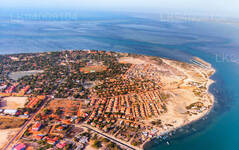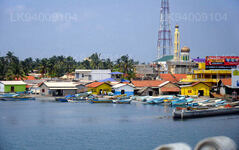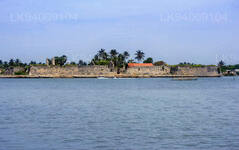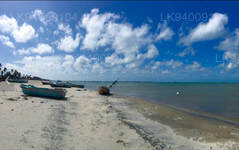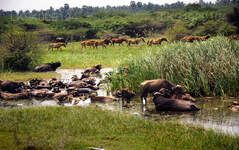
Mannar City
Mannar is the main town of Mannar District, Northern Province, Sri Lanka. It is governed by an Urban Council. The town is located on Mannar Island overlooking the Gulf of Mannar and is home to the historic Ketheeswaram temple.
マナーシティ
場所:マナールはコロンボの北 325 km に位置します。
マナーに到達するマンナール コロンボからマンナールへの通常のルートは、アヌラーダプラとマダワチヤを経由します。
マナー地区スリランカ北部州に属するマナー地区は、本土の一部である地域と国内最大の島であるマナー島で構成されています。マナールへの道はスリランカの乾燥地帯を通ります。マナー地区の風景は、樹木が生い茂るジャングルから水田、揺れるヤシの木までさまざまです。
マナー島マナール島はマナール地区にある乾燥した不毛の半島です。島と呼ばれていますが、実際には舌状に形成された半島です。島の最西端であるタライマナールは、南インドの半島の東端であるダヌスコディと、ポーク海峡に沈むサンゴ礁によってほぼつながっています。
マナー島は、半島と本土を結ぶ細長い土地とは別に、浅瀬にかかる土手道によって接続されており、マダワチヤ - タライマンナール間の幹線道路 A14 の 3 km を形成しています。マナールの小さな漁港は、島の南東の海岸にあります。
マナール島は歴史的に「マンテイ」、「マトータ」、「マハティタ」、「マハプトゥ」、「マワトゥトータ」などの名前で呼ばれてきました。
マナーのハイライト
マドゥの聖マリア教会
マドゥの聖マリア教会 (マドゥの聖母教会) は、マナールの南東 50 km に位置します。マドゥ ロード ジャンクションから A14 マダワチヤ - タライマナール幹線道路を外れ、内陸に車で 12 km (A 378 マドゥ ロード) です。
19 世紀に建てられたポルトガル様式の教会には、教会を訪れるすべての人に祝福をもたらすと信じられているマドゥの聖母像が安置されています。この像は、オランダによる迫害から逃れてきたカトリック教徒によって 1670 年にマドゥに持ち込まれました。人里離れたマドゥの村も、1860 年以上にわたって仏教徒にとって神聖な場所であり、古代ランカにヒンズー教のパティーニ信仰を伝えたガジャ バフ 1 世 (西暦 114 ~ 136 年) の時代からです。
パッティーニ崇拝が、当時首都であり、上座部仏教の輝かしいアジアの学術の中心地であったアヌラーダプラに受け入れられていなかったことに注目することは非常に重要です。パッティーニ デヴァーレ神社は、アヌラーダプラの北西 90 km のマナールに建てられました。ポルトガルがスリランカを統治していた時代、ヒンズー教徒はここをアンマン寺院と呼んでいました。近くのタンクは今でもコヴィル・クラム(デヴァールのタンク)と呼ばれており、これはこの場所のタミル語の名前に由来しています。
頻繁に訪れる巡礼者は、主にパッティーニ アンマ神による治癒力への信仰を目的としてやって来ます。パティーニ・アンマさんの祝福は子供のいない女性たちからも求められている。 1911 年の国勢調査報告書の著者である EB デナム氏は次のように述べています。「これは本質的には森林巡礼です…マドゥの大地は特別な薬効を持っていると考えられており、したがって神聖であり、その結果、『マドゥの薬』の効果で病気が治るという評判が生まれました。ケース。興味深いのは、1911 年にはマドゥに永住者がいなかったことです。 1911 年 3 月 10 日の国勢調査の日、マドゥにいたのは 320 人の巡礼者だけで、そのうち 230 人はコロンボ市とチラウ地区から来たシンハラ人でした。
英国公務員の RW レバーズ氏は、北中部州のマニュアルの中で次のように記録しています。 、パッティーニ・アンマ寺院(アンマン・コヴィル)としてそこに頼る人々。」
1876 年からそこに教会を建設することにより、ジャフナのカトリック司教は、パッティーニ アンマの治癒力に対する古くからの一般的な信仰を、キリスト教信仰における聖母マリアの啓発に都合よく利用しました。しかし、この場所は依然として仏教徒とヒンズー教徒にとって神聖な場所です。
マドゥの祝祭マドゥ祭は8月中旬に開催されます。 8月15日は聖母被昇天の日であり、スリランカ全土から50万人以上の信者が集まると予想されている。ローマ・カトリック教会によれば、聖母被昇天の日は、聖母マリアが地上での生涯を終え、身も魂も天の栄光に移された日を祝う日です。
About Mannar District
Mannar is the capital of Mannar District, Sri Lanka. Mannar District is located in northwestern Sri Lanka. It is one of five administrative districts of the Northern Province. The district covers 2,002 sq. km, approximately 3% of the total land area of Sri Lanka. Geographically the bulk of Mannar is on the mainland within the arid and dry zone. High temperatures and low rainfall characterize the climate. The monthly temperatures range between 26.5°C and 30.0°C with highs normally recorded between May and August. Mannar receives nearly 60% of its rainfall during the northeast monsoon, which lasts from October through December. The land area is relatively flat and sits at low elevations. Towards the interior the terrain is gently undulating, favoring the storage of rainwater in tanks that provide the majority of the irrigation for the district's arable land. The primary economic activities in Mannar are crop cultivation (mainly paddy), fisheries and animal husbandry. Employment opportunities in the district are highly seasonal, and there are no institutional facilities for tertiary education.
About Northern Province
The Northern Province is one of the 9 provinces of Sri Lanka. The provinces have existed since the 19th century but they didn't have any legal status until 1987 when the 13th Amendment to the 1978 Constitution of Sri Lanka established provincial councils. Between 1988 and 2006 the province was temporarily merged with the Eastern Province to form the North-East Province. The capital of the province is Jaffna.
Northern Province is located in the north of Sri Lanka and is just 22 miles (35 km) from India. The province is surrounded by the Gulf of Mannar and Palk Bay to the west, Palk Strait to the north, the Bay of Bengal to the east, and the Eastern, North Central and North Western provinces to the south. The province has a number of lagoons, the largest being Jaffna Lagoon, Nanthi Kadal, Chundikkulam Lagoon, Vadamarachchi Lagoon, Uppu Aru Lagoon, Kokkilai lagoon, Nai Aru Lagoon, and Chalai Lagoon.Most of the islands around Sri Lanka are to be found to the west of the Northern Province. The largest islands are Kayts, Neduntivu, Karaitivu, Pungudutivu, and Mandativu.
The Northern Province's population was 1,311,776 in 2007. The majority of the populations are Sri Lankan Tamils, with a minority Sri Lankan Moor and Sinhalese population. Sri Lankan Tamil is the major language spoken in the province by the vast majority of the population. The other language spoken is Sinhala by 1 percent of the population. English is widely spoken and understood in the cities.
【Text by Lakpura™. Images by Google, copyright(s) reserved by original authors.】

